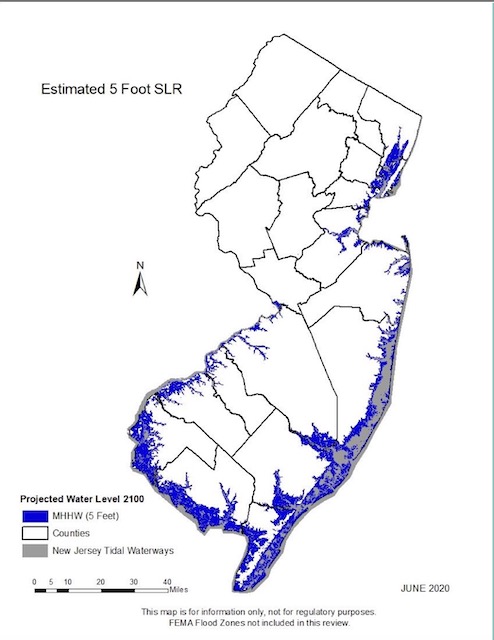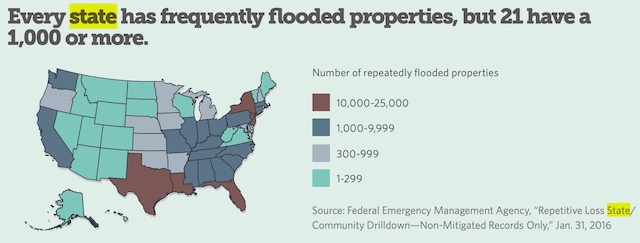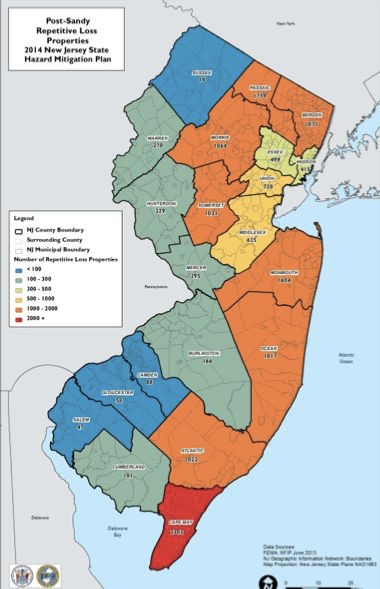A Whole New Angle On Underwater Mortgages
Lax Restrictions On New Development And Reconstruction Could Jeopardize Future Federal Funds
Floating a Vague Trial Balloon Days Before Christmas Is No Way To Build Public Support
Inundation –[in-uhn-dey-shuhn] noun
1. the condition of being flooded: Researchers are warning that accelerated sea level change threatens hundreds of thousands of coastal homes with inundation.
2. a flood: Areas shaded in purple on the map may see an inundation of 3 to 12 feet.
The DEP’s road map completely fails with respect to inundation, flood hazard restrictions, repetitive loss and strategic retreat planning.
It also is silent on and misses a huge opportunity to impose real “green building standards”, which, at a minimum, would mandate electrification of new and phased electrification of existing buildings –
Finally, I see no carbon sequestration strategy (afforestation, urban heat island, etc) or requirements –
Three days before Christmas, the Murphy DEP released outlines (or “road maps” ) of the long delayed and overdue package of climate regulations known as “PACT” (for Protecting Against Climate Threats). The package has 2 basic parts: “mitigation” (reducing greenhouse gas emissions) and “adaptation” (responding to the impacts of climate change).
The road map to the package of “adaptation” land use regulations is called “REAL” (for Resilient Environment and Landscapes).
Not since the notorious flaming failure of The BIG MAP has DEP been so creatively deceptive with acronyms. Let’s hope for a better outcome this time around! (and we have’t yet reviewed whether the DEP’s REAL proposal addresses FEMA’s strong criticism of DEP’s stormwater rules las year).
Of course this misguided DEP rollout tactic generated generally favorable coverage by NJ Spotlight, with Tom Johnson writing about the “mitigation” (greenhouse gas emissions reduction) side and Jon Hurdle writing about the “adaption” side.
Today I want to make just a few large points on the adaption package.
Tom Johnson’s Spotlight story didn’t provide a link to DEP’s mitigation “road map” and there was nothing on DEP’s PACT webpage. From the story, it almost sounded like DEP provided an oral briefing to a select group of DEP picked “Stakeholders” and media, with no written backup. I can’t think of a worse way to present a program. It literally invites the fact free spin and sloganeering that Tom Johnson parrots in his story.
Because we were not an invited “Stakeholder”, we have absolutely nothing to review or comment on. So I’ll leave readers with Tom Johnson’s characterization:
While short on specifics, DEP staffers gave a broad outline last week on how the state intends to crack down on both so-called stationary sources of global warming pollution — like power plants and commercial and industrial boilers — and mobile sources, such as medium- and heavy-duty trucks that primarily rely on fossil fuels to move goods around.
The specifics and outline in Tom’s story are so broad as to be meaningless.
But because certain specific programs were mentioned in the story, for now I must note that we previously wrote about the lack of climate protections in DEP’s boiler rules and the totally inadequate scale/scope of the electric vehicle program. By way of context, DEP appears to regulate boilers of only 5 million BTUs/hour. Yet just last year, as I wrote, DEP rolled back regulations for boilers 10 times larger, 50 million BTU’s/hour. Why is DEP not going after greenhouse gas emissions from those larger boilers?
Strong going forward suggestions to DEP:
1) you need to “score” all the regulatory proposals you outline in terms of greenhouse gas emissions reductions they would produce.
If you don’t, you invite the continued spin and the misplaced focus on compliance costs.
2) you have to do these briefings far more transparently and with broad public awareness and engagement.
Continued reliance on your hand picked “Stakeholders” is a formula for failure.
Now back to the REAL land use “road map”.
The DEP road map has fatal flaws.
NJ is one of the worst states in the country for repetitive flood damage claims. NJ is right up there among the worst with Texas, Florida and NY. NJ has a tiny fraction of the land area, coastline, and river/stream miles of those states, which just shows how bad NJ development regulation and land use planning are.
Yet, despite projections of sea level rise that will inundate lands, the DEP proposal would allow new development in those areas.
The DEP would allow development that was destroyed by flooding to be rebuilt in lands projected to be inundated.
The proposed DEP “hardship waiver” approach is not a ban. By its individual case by case and site specific nature, it is the antithesis of regional planning, which calls for a science based regional approach to multiple individual land parcels (ironically, DEP misleadingly calls their approach “watershed based”). Hardship waivers will be issued and will continue to put people and property at deadly risk.
DEP has no problem incorporating land use planning in regulations when they promote development (i.e. the DEP CAFRA regulations relax environmental protections, increase allowable impervious cover, and increase development density in State Plan mapped coastal centers). This is particularly flawed because DEP did not control the State Plan center policies or the entire coastal center mapping program adopted by the State Planning Commission. State Plan designated growth centers are recognized in DEP’s Highlands regulations as well.
So, I can not understand why DEP can’t incorporate regional planning and climate science based standards that restrict development in their PACT regulations (and DEP’s CAFRA, Waterfront Development, Wetlands, and Flood Hazard regulations ) and move away from a site specific approach, particularly given DEP’s complete institutional control of the underlying Coastal Planning and regulatory processes.
I could not find a discussion of coastal and back bay lands that are projected to be impacted by storm surge and wave action or combined effects of coastal and river flooding.
Homes on even higher stilts is not an acceptable solution – would residents of inundated areas kayak to stores and work? Obviously, only very wealthy people can afford to live in such a high cost home. This lands new meaning to “gated community”.
Inland, the DEP would allow existing development destroyed by flooding to be rebuilt in flood hazard zones, thereby perpetuating the repetitive flood insurance claim problem.
The DEP proposal doesn’t even go as far as the NJ Hazard Mitigation Plan’s “Repetitive Loss Strategy” (2019) (Chapter 8) and may jeopardize future federal funding because it will not reduce the number of repetitive loss claims:
8.1.2 REQUIREMENTS FOR REPETITIVE LOSS STRATEGY
To be eligible for an increased federal cost share, a FEMA-approved state or tribal (standard or enhanced) mitigation plan that addresses RL properties must be in effect at the time of grant award and the property must be a RL property. Guidance on addressing repetitive loss properties can be found in the State Multi-Hazard Mitigation Planning Guidance and in 44 Code of Federal Regulations (CFR) Section 201.4(c)(3)(v). The State’s RL Strategy, as detailed in this section, will identify the specific actions the State has taken to reduce the number of RL properties, which must include SRL properties. In addition, the hazard mitigation plan must describe the State’s strategy to ensure that local jurisdictions with SRL properties take actions to reduce the number of these properties, including the development of local or tribal mitigation plans.
The only answer to the inundation, expanding flooding, and repetitive claim problems is to ban development and to prohibit rebuilding of development destroyed by flooding (one and done). We’ve written about how to address NJ’s “right to rebuild”.
This kind of “strategic retreat” must be planned carefully, not done via piecemeal regulation.
The DEP’s road map completely fails with respect to inundation, flood hazard restrictions, repetitive loss and strategic retreat planning.
It also is silent on and misses a huge opportunity to impose real “green building standards”, which, at a minimum, would mandate electrification of new and phased electrification of existing buildings –
Finally, I see no carbon sequestration strategy (afforestation, urban heat island, etc) or requirements –
More to follow on all that.




Pingback: WolfeNotes.com » NJ LCV Announces Another Four Years Of Cheerleading and Political Cover For Gov. Murphy
Pingback: WolfeNotes.com » Murphy DEP, Pinelands Commission, and Highlands Council Urged To Restrict New Development In Areas Of “Extreme” Wildfire Risk